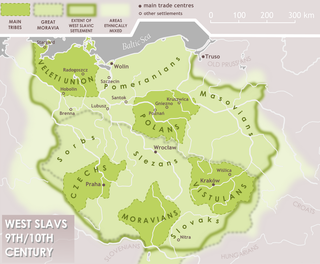Related Research Articles

Lusatia is a historical region in Central Europe, split between Germany and Poland. Lusatia stretches from the Bóbr and Kwisa rivers in the east to the Pulsnitz and Black Elster rivers in the west, and is located within the German states of Saxony and Brandenburg as well as in the Polish voivodeships of Lower Silesia and Lubusz. Lusatia's central rivers are the Spree and the Lusatian Neisse, which constitutes the border between Germany and Poland since 1945. The Lusatian Mountains, separate Lusatia from Bohemia in the south. Lusatia is traditionally divided into Upper Lusatia and Lower Lusatia.

The Pomeranians, first mentioned as such in the 10th century, were a West Slavic tribe, which from the 5th to the 6th centuries had settled at the shore of the Baltic Sea between the mouths of the Oder and Vistula Rivers. They spoke the Pomeranian language that belonged to the Lechitic languages, a branch of the West Slavic language family.

Lithuania Minor, or Prussian Lithuania, is a historical ethnographic region of Prussia, where Prussian Lithuanians lived, now located in Lithuania and the Kaliningrad Oblast of Russia. Lithuania Minor encompassed the northeastern part of the region and got its name from the territory's substantial Lithuanian-speaking population. Prior to the invasion of the Teutonic Knights in the 13th century, the main part of the territory later known as Lithuania Minor was inhabited by the tribes of Skalvians and Nadruvians. The land depopulated during the incessant war between Lithuania and the Teutonic Order. The war ended with the Treaty of Melno and the land was repopulated by Lithuanian newcomers, returning refugees, and the remaining indigenous Baltic peoples; the term Lithuania Minor appeared for the first time between 1517 and 1526.

The Western Polans, also known as Polans, and Polanians, were a West Slavic and Lechitic tribe, inhabiting the Warta River basin of the contemporary Greater Poland region starting in the 6th century. They were one of the main tribes in Central Europe and were closely related to the Vistulans, Masovians, Czechs and Slovaks.

Silesians is a geographical term for the inhabitants of Silesia, a historical region in Central Europe divided by the current national boundaries of Poland, Germany, and the Czech Republic. Historically, the region of Silesia has been inhabited by Germans, Czechs, Poles, and Slavic Upper Silesians. Therefore, the term Silesian can refer to anyone of these ethnic groups. However, in 1945, great demographic changes occurred in the region as a result of the Potsdam Agreement leaving most of the region ethnically Polish and/or Slavic Upper Silesian.

The Veleti, also known as Veletians, Wilzi, Wielzians, and Wiltzes, were a group of medieval Lechitic tribes within the territory of Hither Pomerania, related to Polabian Slavs. They had formed together the Confederation of the Veleti, also known as the Union of the Veleti, a loose monarchic confederation of the tribes. Said state existed between the 6th and 10th centuries, after which, it was succeeded by the Lutician Federation.

Upper Lusatia is a historical region in Germany and Poland. Along with Lower Lusatia to the north, it makes up the region of Lusatia, named after the Slavic Lusici tribe. Both parts of Lusatia are home to the West Slavic minority group of the Sorbs.

Lebus is a historic town in the Märkisch-Oderland District of Brandenburg, Germany. It is the administrative seat of Amt Lebus. The town, located on the west bank of the Oder river at the border with Poland, was the centre of the historical region known as Lubusz Land, which provides the name for the present-day Polish Lubusz Voivodeship.

Pieńsk is a town in Zgorzelec County, Lower Silesian Voivodeship, in south-western Poland. It is the seat of the administrative district (gmina) called Gmina Pieńsk, and stands on the east bank of the Lusatian Neisse river, which forms the border between Poland and Germany.

Wolin is a town in northwestern Poland, situated on the southern tip of the Wolin island off the Baltic coast of the historic region of Western Pomerania. The island lies at the edge of the strait of Dziwna in Kamień County, West Pomeranian Voivodeship.

Liubice, also known by the German name Alt-Lübeck, was a medieval West Slavic settlement near the site of modern Lübeck, Germany. Liubice was located at the confluence of the Schwartau with the Trave across from Teerhof Island, approximately four kilometres north of Lübeck's island old town. The residence of Henry, the Christian prince of the Obotrites, Liubice was destroyed after his death by the pagan Rani of Rugia.

The most important phenomenon that took place within the lands of Poland in the Early Middle Ages, as well as other parts of Central Europe was the arrival and permanent settlement of the West Slavic or Lechitic peoples. The Slavic migrations to the area of contemporary Poland started in the second half of the 5th century AD, about a half century after these territories were vacated by Germanic tribes fleeing from the Huns. The first waves of the incoming Slavs settled the vicinity of the upper Vistula River and elsewhere in the lands of present southeastern Poland and southern Masovia. Coming from the east, from the upper and middle regions of the Dnieper River, the immigrants would have had come primarily from the western branch of the early Slavs known as Sclaveni, and since their arrival are classified as West Slavs and Lechites, who are the closest ancestors of Poles.

Pomerania during the Early Middle Ages covers the History of Pomerania from the 7th to the 11th centuries.

Pomerania during the High Middle Ages covers the history of Pomerania in the 12th and 13th centuries.

After the glaciers of the Ice Age in the Early Stone Age withdrew from the area, which since about 1000 AD is called Pomerania, in what are now northern Germany and Poland, they left a tundra. First humans appeared, hunting reindeer in the summer. A climate change in 8000 BC allowed hunters and foragers of the Ertebølle-Ellerbek culture to continuously inhabit the area. These people became influenced by farmers of the Linear Pottery culture who settled in southern Pomerania. The hunters of the Ertebølle-Ellerbek culture became farmers of the Funnelbeaker culture in 3000 BC. The Havelland culture dominated in the Uckermark from 2500 to 2000 BC. In 2400 BC, the Corded Ware culture reached Pomerania and introduced the domestic horse. Both Linear Pottery and Corded Ware culture have been associated with Indo-Europeans. Except for Western Pomerania, the Funnelbeaker culture was replaced by the Globular Amphora culture a thousand years later.
The Gustow group is an archaeological culture of the Roman Iron Age in Western Pomerania. The Gustow group is associated with the Germanic tribe of the Rugii.

The Lutici or Liutizi were a federation of West Slavic Polabian tribes, who between the 10th and 12th centuries lived in what is now northeastern Germany. Four tribes made up the core of the federation: the Redarians, Circipanians (Circipani), Kessinians and Tollensians (Tholenzi). At least in part, the Lutici were a continuation of the Veleti. In contrast to the former and the neighboring peoples, the Lutici were not led by a Christian monarch or duke, rather power was asserted through consensus formed in central assemblies of the social elites, and the Lutici worshipped nature and several deities. The political and religious center was Radgosc.

John I, Margrave of Brandenburg was from 1220 until his death Margrave of Brandenburg, jointly with his brother Otto III "the Pious".

The Golensizi were a tribe of West Slavs, specifically of the Lechitic tribes, living in the Early Middle Ages and inhabiting southern territories of what was later known as Upper Silesia, on the upper Oder River.

Ostsiedlung is the term for the Early Medieval and High Medieval migration of ethnic Germans into the territories in the eastern part of Francia, East Francia, and the Holy Roman Empire and beyond; and the consequences for settlement development and social structures in the areas of immigration. Generally sparsely and in some inland areas only relatively recently populated by Slavic, Baltic and Finnic peoples, the area of colonization, also known as Germania Slavica, encompassed Germany east of the Saale and Elbe rivers, the states of Lower Austria and Styria in Austria, Estonia, Latvia, Poland, the Czech Republic, Slovakia, Slovenia, Hungary, and Transylvania in Romania.
References
- 1 2 3 Joachim Herrmann (editor): Die Slawen in Deutschland. Geschichte und Kultur der slawischen Stämme westlich von Oder und Neiße vom 6. bis 12. Jahrhundert. Ein Handbuch. Berlin, 1985. (in German)
- 1 2 Lech Leciejewicz: Mały słownik kultury dawnych Słowian. Warsaw: Wiedza Powszechna, 1972. (in Polish)